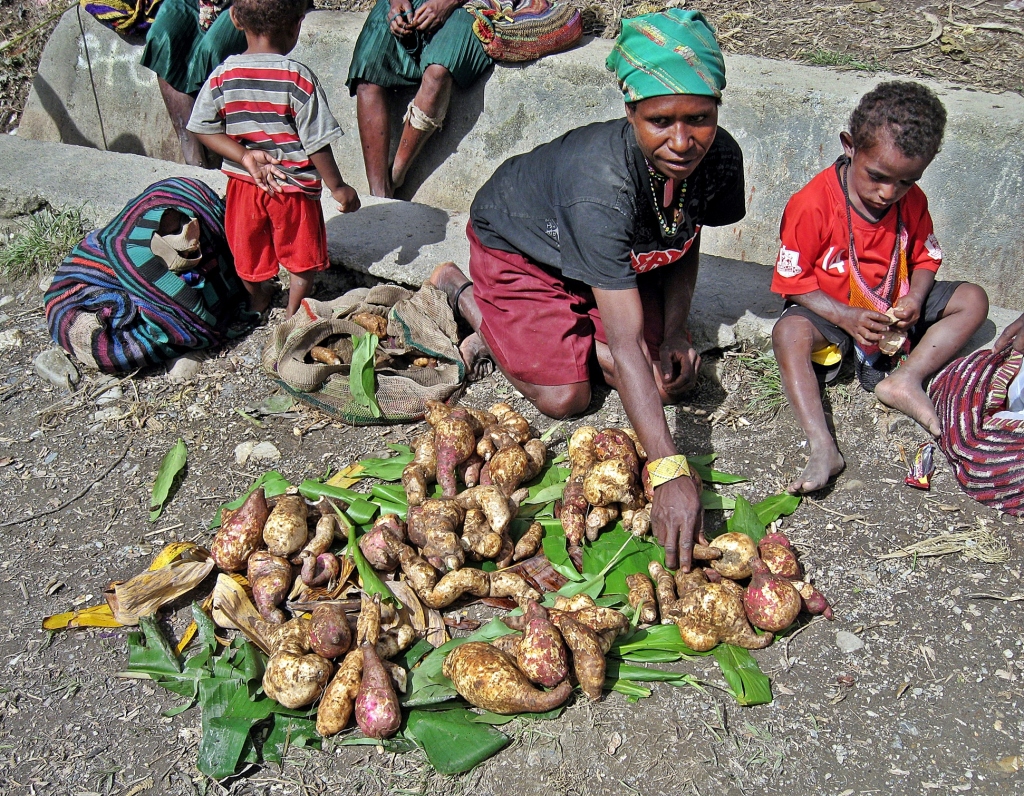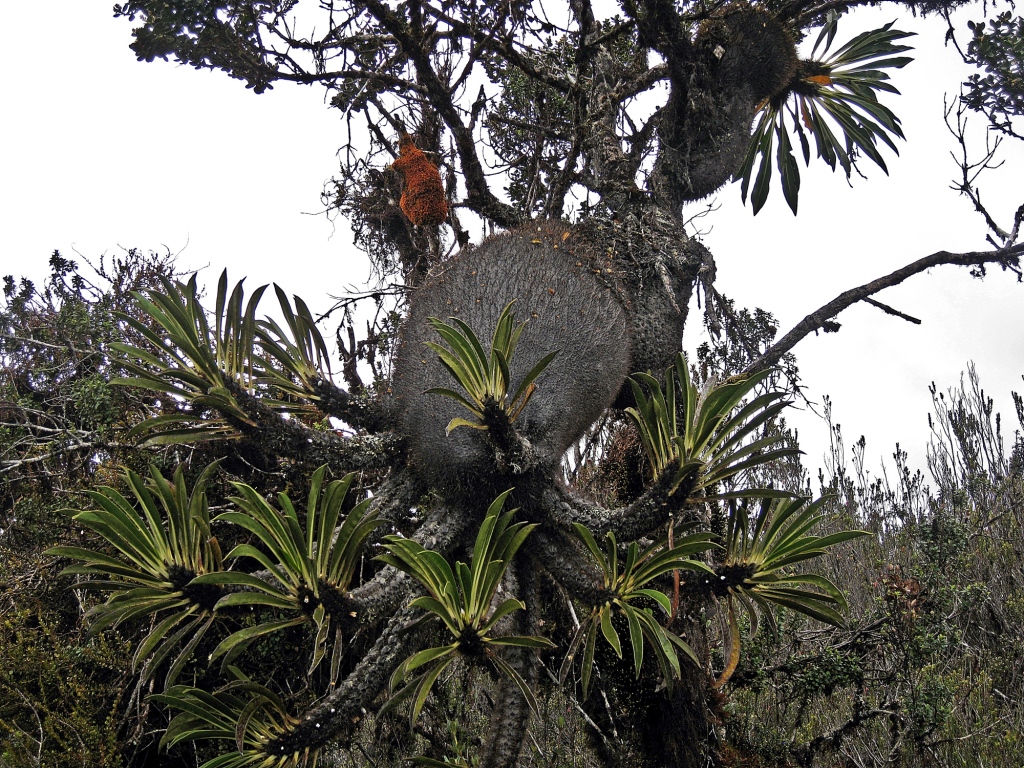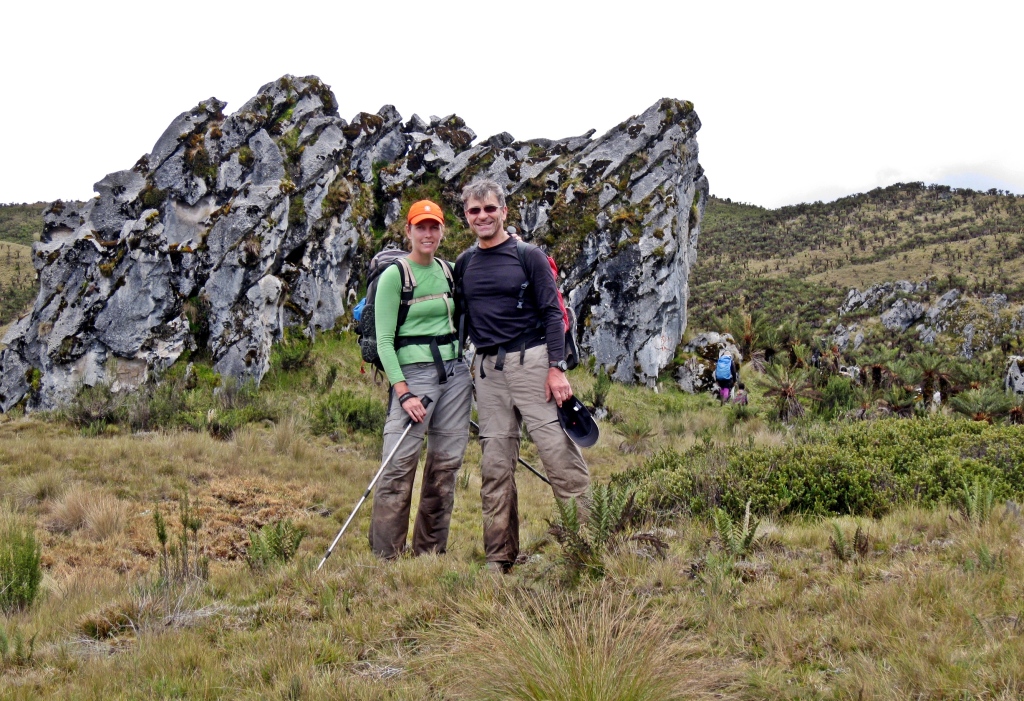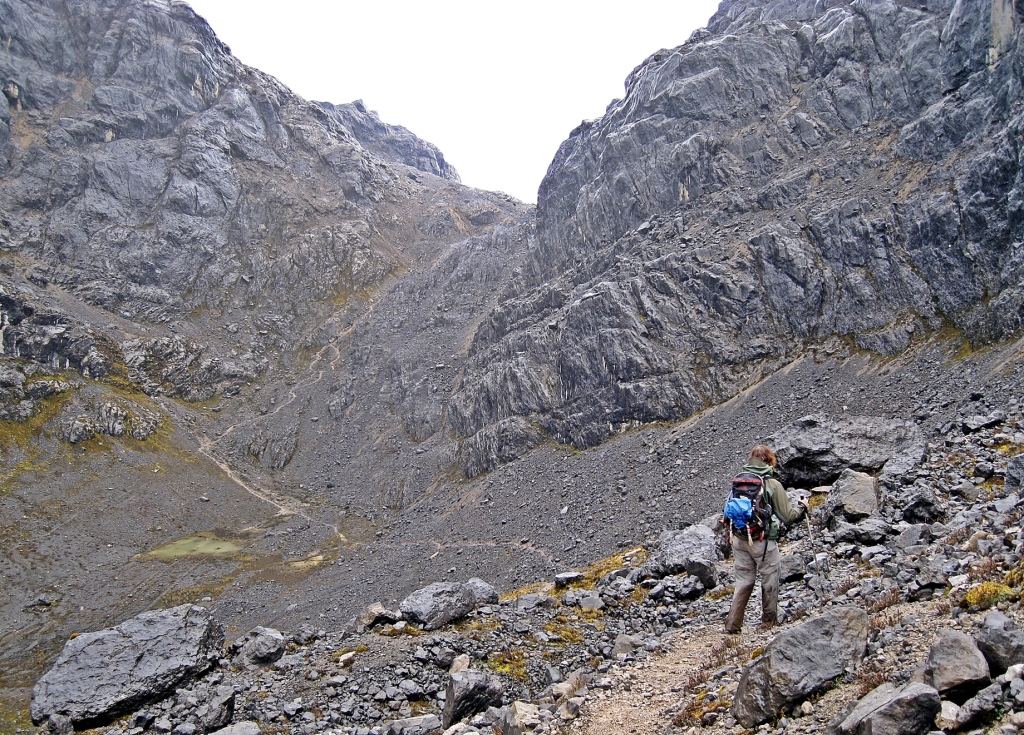It was still dark and cold when we reached the fixed ropes. Our thick gloves made it more difficult to use the ascenders, but it was too cold to go without. Finally, after 5 tough days of hiking through the Papuan jungle, the summit of Carstensz Pyramid was within our reach.
Carstensz Pyramid (Puncak Jaya in Malay) is the highest peak on Mount Carstensz (Jayawijaya) in Indonesia. At 4,884 m it is the highest mountain on the Australasian continental shelf. To mountaineers, climbing the seven summits, the highest mountain on each continent is a highly regarded achievement. Mt. Kosciusko in Australia was thought by some to be the highest for this continent, but as it is only 2,228 m high, mountaineers sought out a higher mountain. Carstensz Pyramid was deemed to be its replacement as one of the official peaks of the Seven Summits.

Carstensz Pyramid
This story is part of a series ‘Seven Summits’. New chapters will be released over the next few months.
Richard was on his way to accomplishing one of mountaineering’s highest objectives; completing the Seven Summits. Maggie tagged along on this expedition but wasn’t completing the seven summits. Our journey began on a flight from Denpasar, Bali to Timika in the Indonesian province of Papua. Arriving in Timika, we knew we had left touristy Bali behind. It was our first time seeing the distinctive red spit from the betel nut, and the intense, curious stares from locals. After a long wait in Timika’s small airport, we boarded a second small plane bound for Sugapa, deep in the jungles of Papua. The landing strip in Sugapa is a small, short piece of flat land between two dramatic cliffs. Our pilot was one of the best we’ve ever had. He negotiated the tricky terrain with ease.
In Sugapa, we stayed overnight in a local house where we met the other 12 members of the climbing expedition as well as our 3 guides and their assistants.

Timika Airport, Papua Province 
Sugapa runway pigs 
Main street, Sugapa
In the morning, the adventure began, but it wasn’t a climbing adventure yet. The adventure was watching the intense negotiations between our guides and the Dani tribe leaders. Our expedition needed to hire local villagers to work as porters. There had to be an equal number of porters from each village to ensure we didn’t incite fights between the villages. Each tribal chief was negotiated with separately and some of these talks became quite heated. It was an indication of things to come.
The negotiations took most of the morning and since we weren’t involved, we spent our time checking out the local market where we were as much an interest to the locals as they were to us. Many men in the village were dressed in traditional attire wearing only a gourd in front and a small square of leather over the buttocks. These men carried large bows and arrows, and some wore headdresses. They looked to us as if they were still headhunters. We were told that these Dani tribes stopped that practice in the 1960s, but that still meant that many of the tribal elders would had been cannibals. That thought didn’t escape us for our entire time in Papua.

Dani Chief, Sugapa 
Dani tribe, Sugapa 
Yams at the market, Sugapa 
Dani Chief, Sugapa 
Dani Chief, Sugapa 
Meeting the locals, Sugapa 
Market, Sugapa 
Dani tribe, Sugapa
Finally, by noon, we were on our way. We were escorted by armed soldiers to the outskirts of Sugapa, but didn’t even reach the first village when our porters stopped and demanded more money. No one was allowed to pass, until a new agreement was reached. Our guides expected these re-negotiations, so they knew the initial sum wouldn’t be the final price. In fact, we had these stoppages almost daily. It made us a little leery to let these men carry our personal bags of expensive mountaineering equipment, but we didn’t have much choice, and they knew it.

Soldier escort, Sugapa 
Jungle, Papua Province 
Dani village, Papua Province 
Villager and his pig, Papua Province
Our guiding company had to find new trekking routes through different villages every few months. After a few trips, the village chiefs demanded extreme amounts of money for or refused to allow expeditions to pass. The route we were taking had only been used once before. That meant that there really wasn’t a trail. The first 4 days of the trek to base camp was through a dense, wet jungle We spent most of the first two days walking along and across layers and layers of fallen over trees that were wet and greasy making them difficult to navigate. Often, we were 10 meters off the ground with only rotting logs to break our fall.

Hiking through a village, Carstensz Pyramid Trek 
Walking across slippery logs, Carstensz Pyramid Trek 
Jungle, Papua Province
When we weren’t walking on fallen over logs, we were walking through swamps, mud pools and even up rivers. Before the trek began, we couldn’t understand why our guides wouldn’t let us wear our mountaineering boots, but instead insisted that we wear rubber boots. It didn’t take long for us to realize why. It poured every single day of the 5-day trek to base camp making the already saturated ground almost impassable.

Hiking through boggy ground on the way to Carstensz Pyriamid 
Waterfall, Carstensz Pyramid Trek
Each night, our camps were established on the flattest ground we could find in the thick jungle. Often, they had to cut away trees with machetes to make enough room. We camped on riverbanks and on small flat spaces on the side of hills; anywhere where we could find flat, reasonably dry ground.
The most unusual part about bringing tribal porters was that most of the village came with us too. The porters brought their wives and children, including infants, on our rugged 12-day, 60 km expedition. Two women were over 5 month’s pregnant. None had shoes. They brought yams for their meals, which were cooked over an open fire. At camp, they erected crude frames where they draped tarps for shelter. Initially all of the porters and their families stayed in one shelter, or separate shelters, but very close together. That didn’t last long though.

Campsite, Carstensz Pyramid Trek 
Campsite in the bushes, Carstensz Pyramid 
Porters’ wives and baby, Carstensz Pyramid Trek 
Porter shelter, Carstensz Pyramid Trek 
Camp with porters’ shelter behind, Carstensz Pyramid Trek
Over the first few days we started to get to know some of the porters and their families. Half of the group were friendly. We couldn’t speak to each other, so we used typical arm waving and gestures to communicate. During one downpour, a bunch of us crowded into a small shelter for lunch. The families were Christian and before their meal, they were led in prayer. We bowed our heads until they were done. One of the ladies and Maggie caught each other’s eye during the prayer and smiled at each other. At the end of the prayer the villagers all said ‘amen’, so Maggie did too. This lady laughed and laughed and kept saying ‘Amen, Amen’ thinking Maggie had said a word from their local language!!
But they weren’t all friendly. Some of the porters’ demands started to become more outrageous and a division developed between the villages. One side was kind and knew they were getting a fare wage, but the other side was aggressive. They demanded more and more money and even claimed we were stealing their yams! They started to set up two different camps each night to stay as far away from each other as possible.

Sharing a shelter with our porters
When we finally emerged from the dense jungle, we had beautiful views of small hills covered by unusual looking tree-ferns and the sarang semut plant. These plants are often sliced in half as route markers. They claim this plant can cure everything from asthma to cancer. The terrain also had interesting limestone rock formations, similar to the Pinnacle Trek in Borneo. As our views opened up we could see the mountains of the Sudirman Range, letting us know we were getting closer to our goal.

Tree fern forest, Carstensz Pyramid Trek 
Tree fern and sarang semut plant 
Sarang semut plant, Papua Province 
Tree fern forest, Carstensz Pyramid Trek 
Sudirman Range, Papua Province 
Sarang semut plant, Papua Province 
Karst pinnacles, Carstensz Pyramid Trek 
Karst pinnacles, Carstensz Pyramid Trek 
Sudirman Range, Papua Province 
Porter’s wife and infant, Carstensz Pyramid Trek 
Carstensz Pyramid Trek 
Mountain views, Carstensz Pyramid Trek 
Carstensz Pyramid Trek 
Porter’s children, Carstensz Pyramid Trek 
Tree ferns, Carstensz Pyramid Trek 
Carstensz Pyramid Trek 
Orchid, Papua Province 
Rickety bridge, Carstensz Pyramid Trek
Thankfully, the final day of the trek to base camp was on a dry trail. We walked on shale, up and down hills and beside large mountain tarns. We were in the clouds as we hiked up the steep rocky path to New Zealand Pass. From the top we got our first look at the limestone slabs of Carstensz Pyramid. It’s a formidable looking wall with a sheer limestone face. At the base of the pass is the Valley of Ten Lakes. Basecamp was to be set up on the shore of one of these lakes.

Mountain tarn, Carstensz Pyramid Trek 
Mountain tarn, Carstensz Pyramid Trek 
Steep trail, Carstensz Pyramid Trek 
In the clouds, Carstensz Pyramid Trek 
Carstensz Pyramid Trek 
Limestone walls, Carstensz Pyramid Trek 
Carstensz Pyramid Trek 
Limestone towers, Carstensz Pyramid Trek 
Carstensz Pyramid Trek 
New Zealand Pass, Carstensz Pyramid 
Carstensz Pyramid 
Valley of the Ten Lakes, Carstensz Pyramid 
Carstensz Pyramid 
A porter negotiating the sharp, cold rock, above Carstensz Pyramid basecamp
On summit day, we woke at 3 am and were happily surprised to see stars. That meant that it wasn’t cloudy and therefore may not rain. What luck! We hiked for an hour in the dark to the base of the wall where there were fixed ropes. It was quite cold at 4,000 m elevation, so we were all dressed in gortex jackets, thick gloves and balaclavas under our climbing helmets. It was still dark as we began the ascent up the 600m wall. The steepness of the wall required scrambling; using hands and feet. The darkness made it difficult to see hand and foot holds or even which way the route went. Managing the ascenders on the ropes with thick gloves was a little difficult, but it was too cold to go without. We scrambled up the rock face going through chimneys, gullies and along cracks. Finally, after an hour and a half, we had reached the top of the ridge, but the route didn’t get easier. We had to stay on fixed ropes as we navigated the narrow ridge and its deep notches. The most challenging part of our climb was crossing a 30m wide gap. To cross this gap would mean doing at least a grade 5.8 technical climb which at these temperatures and elevation would have been very challenging. Instead, guiding companies installed a Tyrolean Traverse. Attached to a fixed cable, we had to pull ourselves across the 20m deep, 30m wide gap. We were lucky to have our guide Poxi to help us get across. He scooted across the traverse on his own with ease. From the other side he was able to assist us, by pulling us across the traverse. Although we helped him by pulling on the cables ourselves, he did most of the work to get each one of us across. It was exhilarating!

Fixed ropes, Carstensz Pyramid 
Fixed ropes, Carstensz Pyramid 
Tyrolean Traverse, Carstensz Pyramid 
Carstensz Pyramid ridge 
Ngga Pulu Peak 
Tyrolean Traverse, Carstensz Pyramid 
Tyrolean Traverse, Carstensz Pyramid 
Tyrolean Traverse, Carstensz Pyramid Trek
From there though we still had to continue along the narrow ridge, passing over large gaps with deep crevasses. From the ridge we had amazing views of the Sudirman Range including Sumantri and Ngga Pulu Peak. There were a lot of clouds, but they made for fantastic pictures. Finally, after 30 minutes, we arrive at the summit! Carstensz Pyramid’s summit is a rocky plateau with a small rock feature that we all proudly stood on for our summit pictures. Another of the 7 summits completed by Richard, and this one also by Maggie.

Carstensz Pyramid’s ridge 
Carstensz Pyramid’s ridge 
Down-climbing, Carstensz Pyramid’s ridge 
Ngga Pulu Peak seen from the ridge 
View from Carstensz Pyramid ridge 
Navigating a gap on Carstensz Pyramid’s ridge 
Carstensz Pyramid summit seen from below 
Maggie and Richard on the summit of Carstensz Pyramid
As they say, summiting is only half way, we still had to get down. That meant re-crossing the Tyrolean traverse with Poxi’s help and rappelling all of the way down the 600m cliff. In the daytime, we were able to see what we had just climbed and it was impressive.

Fixed ropes, Carstensz Pyramid 
Carstensz Pyramid’s imposing wall 
Ngga Pulu Peak seen from the ridge 
Basecamp from far above, Carstensz Pyramid
The next day, we enjoyed a lovely rest day at our lakeside campsite, while the other half of our expedition summited. We needed the rest as we knew we still had to retrace our steps through the swamps and thick jungle. We were treated to a beautiful blue sky, and a gorgeous scene as the surrounding mountains and our colourful tents reflected off the mountain tarn.

Base camp, Carstensz Pyramid 
Base camp, Carstensz Pyramid
Basecamp is very close to a mining operation. Our porters didn’t stay with us at basecamp as it’s very cold. Instead, they descended down to the mining camp. When we saw them 2 days later, most were dressed in miner’s vests and hardhats. We’re not sure if they stole the gear or if they were gifts, but the porters seemed proud to be wearing them.
On our second last day, the daily porter re-negotiations reached a head. They demanded unreasonable amounts of money. Both sides were yelling and fighting. A couple of the porters pulled out their machetes and charged at our guides. It was very intense. In the end they did receive more money, but not nearly the hundreds of dollars that they were demanding. During our final night in Sugapa, the 14 climbers held a meeting where we decided that we would not tip the porters. We all believed that the porters needed to learn how to manage business with climbing expeditions and threatening with machetes is not the way to earn a tip.

Porter negotiation techniques, Carstensz Pyramid Trek 
Porters’ shelter, Carstensz Pyramid Trek
We used Adventure Indonesia as our guiding company and were very pleased with their mountaineering skills, knowledge and their trip organization.
Carstesz Pyramid slide show including video of the Tyrolean Traverse.
This story is part of a series ‘Seven Summits’. New chapters will be released over the next few months. Click on the links: Vinson Massif, Aconcagua
Coming up Next: Hanoi and Halong Bay
For more pictures from Indonesia click here. For pictures from our other trips go to Gallery at Monkey’s Tale.
For more stories from our other adventures, go to Destinations.
If you like what you read, please comment or share (with credit) using the links below.
Awesome adventure. Great write-up, and wonderful pictures.
LikeLiked by 3 people
Thank you. It was certainly a wild adventure!
LikeLike
Congratulations on this achievement. Thanks for sharing. Allan
LikeLiked by 3 people
Thank you Allan, and thanks for reading! By the way we love your blog! We only post once a week so don’t expect a like for like.
LikeLiked by 1 person
My crazy daughter and her “wonderful” husband. Enjoy while you can. See you sometime this fall.
LikeLiked by 2 people
Thanks mom, we’re trying to enjoy life as much and as crazy as we can!
LikeLike
Amazing tale and stunning photos.
LikeLiked by 1 person
wow – what a crazy adventure!
LikeLiked by 3 people
It was definitely more than we expected, but fun to tell after the factl!
LikeLiked by 1 person
You guys have the most amazing adventures. You must have laughed and rolled your eyes at our description of Crib Goch. That was like a baby climb compared to you guys!! So impressive.
Can’t wait to ready your other 7-summits posts.
My mom is here visiting for the weekend. She reiterated her scolding of us for climbing Crib Goch. What a contrast to your mother’s supportive comments. Ha ha! Your mother must be an adventurer. Mine’s not. 🙂
LikeLiked by 2 people
Haha. We are in the mountains all the time so our level of comfort is much different. I love to read stories of hikes and climbs around the world. My mom gave me the inspiration to travel when I was very young. She wasn’t a mountaineer but still adventurous for her time. Keep climbing!!
LikeLiked by 1 person
Really nice post with some great photos! and how lovely looks the basecamp from far above in Carstensz Pyramid.
Thanks for sharing
LikeLiked by 3 people
Thank you, we spent so much time in the jungle and then in clouds that it was great to have the views from high above. Thanks for reading.
LikeLike
What adventure, was certainly eventful! Great photos too
LikeLiked by 2 people
Thanks, it was definitely more of an adventure than we signed up for!
LikeLike
Wow…you guys are so brave.The hiking/climbing alone looks so challenging but also dealing with the negotiations and aggression of some of the porters must have been very uncomfortable. Your photos are gorgeous. Those turquoise lakes are stunning and your people shots, especially the chief, are amazing. I can’t believe that the porters’ families tag along, sans-shoes (such a contrast to all the gear I buy at MEC!). Great read!
LikeLiked by 3 people
Thank Caroline. It was more than we were expecting that’s for sure. It was certainly a shock when we first walked out of our house that morning and saw the gourds! I left some of my gear with my porter. He was one of the nice ones and they have so little.
LikeLiked by 2 people
Thank you for sharing your adventure! So many beautiful pictures! I’m headed for Aconcagua this December!
LikeLiked by 1 person
Good luck on Aconcagua! We’ll release that story too but probably not before Dec. Our next one will be Vinson Massif. Hopefully you’ll post about Aconcagua!
LikeLike